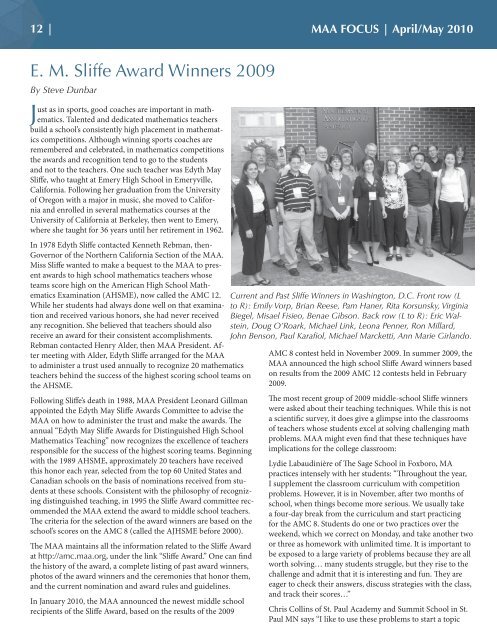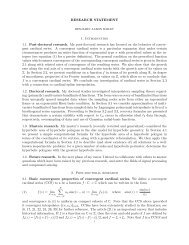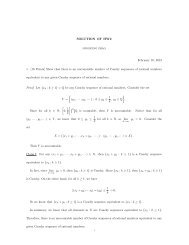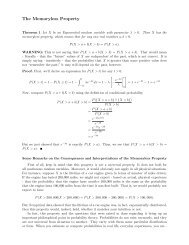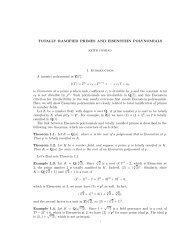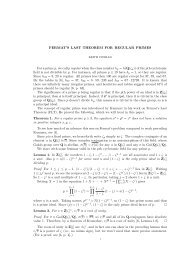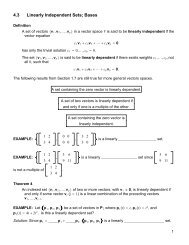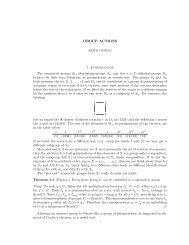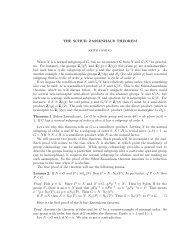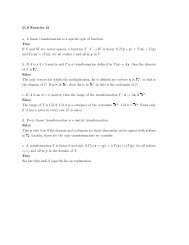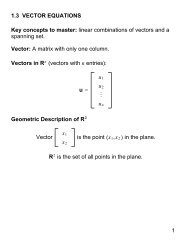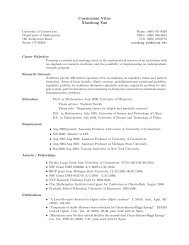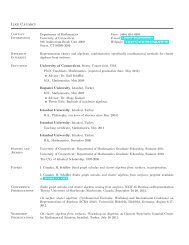April/May 2010 - Department of Mathematics - University of ...
April/May 2010 - Department of Mathematics - University of ...
April/May 2010 - Department of Mathematics - University of ...
You also want an ePaper? Increase the reach of your titles
YUMPU automatically turns print PDFs into web optimized ePapers that Google loves.
�� �<br />
��� ����� � �������<br />
�� �� ������ ����� ������� ����<br />
�� ����� ������<br />
�ust as in sports, good coaches are important in mathematics.<br />
Talented and dedicated mathematics teachers<br />
build a school’s consistently high placement in mathematics<br />
competitions. Although winning sports coaches are<br />
remembered and celebrated, in mathematics competitions<br />
the awards and recognition tend to go to the students<br />
and not to the teachers. One such teacher was Edyth <strong>May</strong><br />
Sli� e, who taught at Emery High School in Emeryville,<br />
California. Following her graduation from the <strong>University</strong><br />
<strong>of</strong> Oregon with a major in music, she moved to California<br />
and enrolled in several mathematics courses at the<br />
<strong>University</strong> <strong>of</strong> California at Berkeley, then went to Emery,<br />
where she taught for 36 years until her retirement in 1962.<br />
In 1978 Edyth Sli� e contacted Kenneth Rebman, then-<br />
Governor <strong>of</strong> the Northern California Section <strong>of</strong> the MAA.<br />
Miss Sli� e wanted to make a bequest to the MAA to present<br />
awards to high school mathematics teachers whose<br />
teams score high on the American High School <strong>Mathematics</strong><br />
Examination (AHSME), now called the AMC 12.<br />
While her students had always done well on that examination<br />
and received various honors, she had never received<br />
any recognition. She believed that teachers should also<br />
receive an award for their consistent accomplishments.<br />
Rebman contacted Henry Alder, then MAA President. After<br />
meeting with Alder, Edyth Sli� e arranged for the MAA<br />
to administer a trust used annually to recognize 20 mathematics<br />
teachers behind the success <strong>of</strong> the highest scoring school teams on<br />
the AHSME.<br />
Following Sli� e’s death in 1988, MAA President Leonard Gillman<br />
appointed the Edyth <strong>May</strong> Sli� e Awards Committee to advise the<br />
MAA on how to administer the trust and make the awards. � e<br />
annual “Edyth <strong>May</strong> Sli� e Awards for Distinguished High School<br />
<strong>Mathematics</strong> Teaching” now recognizes the excellence <strong>of</strong> teachers<br />
responsible for the success <strong>of</strong> the highest scoring teams. Beginning<br />
with the 1989 AHSME, approximately 20 teachers have received<br />
this honor each year, selected from the top 60 United States and<br />
Canadian schools on the basis <strong>of</strong> nominations received from students<br />
at these schools. Consistent with the philosophy <strong>of</strong> recognizing<br />
distinguished teaching, in 1995 the Sli� e Award committee recommended<br />
the MAA extend the award to middle school teachers.<br />
� e criteria for the selection <strong>of</strong> the award winners are based on the<br />
school’s scores on the AMC 8 (called the AJHSME before 2000).<br />
� e MAA maintains all the information related to the Sli� e Award<br />
at ������������������<br />
, under the link “Sli� e Award.” One can � nd<br />
the history <strong>of</strong> the award, a complete listing <strong>of</strong> past award winners,<br />
photos <strong>of</strong> the award winners and the ceremonies that honor them,<br />
and the current nomination and award rules and guidelines.<br />
In January <strong>2010</strong>, the MAA announced the newest middle school<br />
recipients <strong>of</strong> the Sli� e Award, based on the results <strong>of</strong> the 2009<br />
������� ��� ���� ������ ������� �� ���������<br />
�� ��� ����� ����� ����� ������ ��� ������ ��<br />
������� ������ ������� ����� ������� ����<br />
������ ���� �������� ������� ����� ����� �<br />
���� ������� ���� �������� ������� �����<br />
AMC 8 contest held in November 2009. In summer 2009, the<br />
MAA announced the high school Sli� e Award winners based<br />
on results from the 2009 AMC 12 contests held in February<br />
2009.<br />
� e most recent group <strong>of</strong> 2009 middle-school Sli� e winners<br />
were asked about their teaching techniques. While this is not<br />
a scienti� c survey, it does give a glimpse into the classrooms<br />
<strong>of</strong> teachers whose students excel at solving challenging math<br />
problems. MAA might even � nd that these techniques have<br />
implications for the college classroom:<br />
Lydie Labaudinière <strong>of</strong> � e Sage School in Foxboro, MA<br />
practices intensely with her students: “� roughout the year,<br />
I supplement the classroom curriculum with competition<br />
problems. However, it is in November, a� er two months <strong>of</strong><br />
school, when things become more serious. We usually take<br />
a four-day break from the curriculum and start practicing<br />
for the AMC 8. Students do one or two practices over the<br />
weekend, which we correct on Monday, and take another two<br />
or three as homework with unlimited time. It is important to<br />
be exposed to a large variety <strong>of</strong> problems because they are all<br />
worth solving… many students struggle, but they rise to the<br />
challenge and admit that it is interesting and fun. � ey are<br />
eager to check their answers, discuss strategies with the class,<br />
and track their scores…”<br />
Chris Collins <strong>of</strong> St. Paul Academy and Summit School in St.<br />
Paul MN says “I like to use these problems to start a topic


